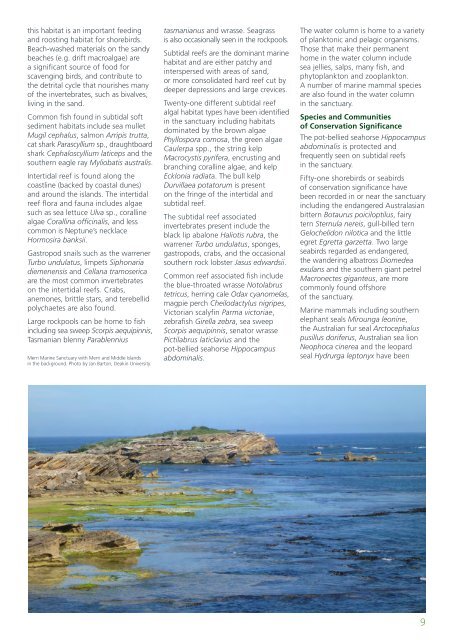Marine Natural Values Study Summary - Parks Victoria
Marine Natural Values Study Summary - Parks Victoria
Marine Natural Values Study Summary - Parks Victoria
You also want an ePaper? Increase the reach of your titles
YUMPU automatically turns print PDFs into web optimized ePapers that Google loves.
this habitat is an important feedingand roosting habitat for shorebirds.Beach-washed materials on the sandybeaches (e.g. drift macroalgae) area significant source of food forscavenging birds, and contribute tothe detrital cycle that nourishes manyof the invertebrates, such as bivalves,living in the sand.Common fish found in subtidal softsediment habitats include sea mulletMugil cephalus, salmon Arripis trutta,cat shark Parascyllium sp., draughtboardshark Cephaloscyllium laticeps and thesouthern eagle ray Myliobatis australis.Intertidal reef is found along thecoastline (backed by coastal dunes)and around the islands. The intertidalreef flora and fauna includes algaesuch as sea lettuce Ulva sp., corallinealgae Corallina officinalis, and lesscommon is Neptune’s necklaceHormosira banksii.Gastropod snails such as the warrenerTurbo undulatus, limpets Siphonariadiemenensis and Cellana tramosericaare the most common invertebrateson the intertidal reefs. Crabs,anemones, brittle stars, and terebellidpolychaetes are also found.Large rockpools can be home to fishincluding sea sweep Scorpis aequipinnis,Tasmanian blenny ParablenniusMerri <strong>Marine</strong> Sanctuary with Merri and Middle Islandsin the background. Photo by Jan Barton, Deakin University.tasmanianus and wrasse. Seagrassis also occasionally seen in the rockpools.Subtidal reefs are the dominant marinehabitat and are either patchy andinterspersed with areas of sand,or more consolidated hard reef cut bydeeper depressions and large crevices.Twenty-one different subtidal reefalgal habitat types have been identifiedin the sanctuary including habitatsdominated by the brown algaePhyllospora comosa, the green algaeCaulerpa spp., the string kelpMacrocystis pyrifera, encrusting andbranching coralline algae, and kelpEcklonia radiata. The bull kelpDurvillaea potatorum is presenton the fringe of the intertidal andsubtidal reef.The subtidal reef associatedinvertebrates present include theblack lip abalone Haliotis rubra, thewarrener Turbo undulatus, sponges,gastropods, crabs, and the occasionalsouthern rock lobster Jasus edwardsii.Common reef associated fish includethe blue-throated wrasse Notolabrustetricus, herring cale Odax cyanomelas,magpie perch Cheilodactylus nigripes,<strong>Victoria</strong>n scalyfin Parma victoriae,zebrafish Girella zebra, sea sweepScorpis aequipinnis, senator wrassePictilabrus laticlavius and thepot-bellied seahorse Hippocampusabdominalis.The water column is home to a varietyof planktonic and pelagic organisms.Those that make their permanenthome in the water column includesea jellies, salps, many fish, andphytoplankton and zooplankton.A number of marine mammal speciesare also found in the water columnin the sanctuary.Species and Communitiesof Conservation SignificanceThe pot-bellied seahorse Hippocampusabdominalis is protected andfrequently seen on subtidal reefsin the sanctuary.Fifty-one shorebirds or seabirdsof conservation significance havebeen recorded in or near the sanctuaryincluding the endangered Australasianbittern Botaurus poiciloptilus, fairytern Sternula nereis, gull-billed ternGelochelidon nilotica and the littleegret Egretta garzetta. Two largeseabirds regarded as endangered,the wandering albatross Diomedeaexulans and the southern giant petrelMacronectes giganteus, are morecommonly found offshoreof the sanctuary.<strong>Marine</strong> mammals including southernelephant seals Mirounga leonine,the Australian fur seal Arctocephaluspusillus doriferus, Australian sea lionNeophoca cinerea and the leopardseal Hydrurga leptonyx have been9
















